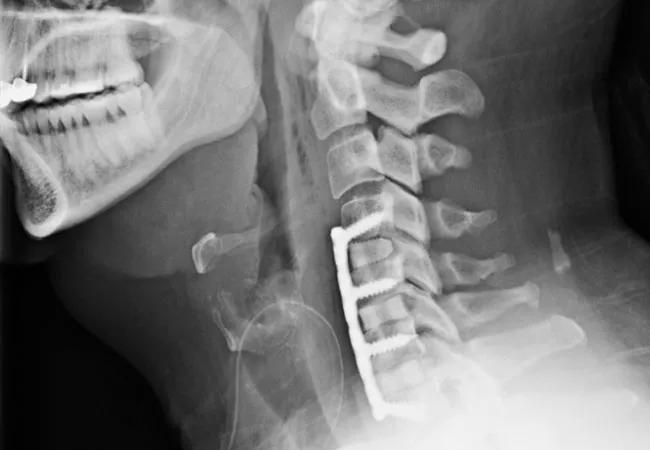Strong patient-physician communication and a conservative approach are essential for recovery

by Jonathan J. Rasouli, MD
Advertisement
Cleveland Clinic is a non-profit academic medical center. Advertising on our site helps support our mission. We do not endorse non-Cleveland Clinic products or services. Policy
Neck pain is a tricky clinical problem, both for the patient and the healthcare provider. While axial neck pain is generally not an indication for surgical intervention, it often co-exists with cervical radiculopathy and myelopathy. We know that degenerative disc disease often considered a normal process of aging, can cause pain due to the altered viscoelasticity of desiccated and aged intervertebral discs. When subjected to normal physiologic forces, degenerative discs exhibit greater deformation and strain, thus altering the normal load-bearing homeostasis of the cervical spine. As one can imagine, this is quite a painful situation!
While many adults will experience at least one substantial neck pain crisis in their lifetime, the vast majority of these episodes are benign and a self-limited process. The majority of neck pain episodes are due to myofascial etiologies. As is the case with myofascial low back pain, we know that myofascial neck pain rarely improves with surgical intervention. So when do we, as surgeons, operate on patients with degenerative cervical disease who present with predominantly neck pain? As with many questions in spine surgery, the answer is not so clear. In patients who present with axial neck pain of greater than 12-weeks duration and have failed initial conservative measures, there are some circumstances where surgical intervention can be considered.
In general, patients with degenerative cervical spondylosis who present with refractory neck pain that is not mechanical will rarely improve with surgery. However, there are some specific subsets of neck pain patients who have demonstrated symptomatic relief in small case series: facetogenic pain and discogenic pain. Patients with discogenic neck pain, or pain that is attributable to a highly degenerative intervertebral disc, demonstrated some relief of symptoms after anterior cervical discectomy and fusion (ACDF) in a small case-series by Palit and colleagues.
Advertisement
In this study, neck pain patients who had a single degenerative disc, failed conservative management and had a positive concordant discogram demonstrated improvements in visual analog scale pain and neck disability index after ACDF. Similarly, patients who have axial neck pain that is attributable to a degenerative facet joint can potentially improve after cervical fusion; however, the body of literature supporting this is lacking. In general, there is weak literature to support surgical intervention for axial neck pain when the patient has exhausted virtually all conservative options and there is a potential pain generator. It should also be mentioned that patients with cervical spine deformity, most commonly kyphosis, can often present with neck pain due to compensatory overactivation of the trapezius muscle in order to maintain a horizontal gaze and straight posture (kyphosis-trapezius sign).
I do not believe neck pain in the absence of cervical spine deformity or radicular and/or myelopathic symptoms is a good indication for surgery. We know that conservative measures such as the temporary use of a soft collar, lifestyle modifications, non-opioid analgesics and occasionally botulinum toxin (Botox) injections are very successful in treating axial neck pain. The current data for surgical intervention in patients with neck pain is spotty at best. Posterior surgical approaches reserved for procedures like cervical laminectomy/fusion and laminoplasty have been shown to increase post-operative neck pain; furthermore, the natural history of axial neck pain is generally benign and self-limiting. A patient with constant, unremitting pain that does not respond to any treatments should be closely evaluated for the presence of co-morbid psychiatric conditions that may somaticize as neck pain. Most importantly, obtain a thorough and accurate history and physical exam, maintain clear and honest lines of communication between the patient and physician and avoid the “trap” of overtreatment.
Advertisement
Axial neck pain is best treated with conservative therapies and a close physician-patient relationship. There are rare instances, which are still controversial, in which surgical intervention may be of some benefit. These instances are primarily in the setting of discogenic neck pain; however, this is primarily a diagnosis of exclusion. Once again, the most important therapeutic goal is to avoid overtreatment and polypharmacy. We know the vast majority of axial neck pain episodes are a self-limited process, so we should strive to educate our patients and set realistic expectations for recovery.
Bibliography:
Boden SD, McCowin PR, et al. Abnormal magnetic resonance scans of the cervical spine in aymptomatic subjects. A prospective investigation. J Bone Joint Surg Am 1990; 72(8): 1178-1184.
Palit M, Schofferman J, Goldthwait N, et al. Anterior discectomy and fusion for the management of neck pain. Spine 1999; 24(21): 2224-2228.
Rinkus K, Rhee JM. Evaluation of axial neck pain – Who is a surgical candidate and who isn’t: how to manage the nonoperative treatment, how to work up the pathology. Textbook of Spinal Surgery, 3rd Volume 1 . Chapter 21. Editor: Bridwell, KH and DeWald RL. 2011.
Advertisement
Advertisement

Case study of radial-to-axillary nerve transfer for tumor-related deltoid nerve injury

An update on the technology from the busiest Gamma Knife center in the Americas

Real-time adjustments may help reduce bothersome dyskinesias

Anatomical modeling can identify optimal surgical candidates, study suggests

Add AI to the list of tools expected to advance care for pain patients

New guidelines from Brain Trauma Foundation urge early and aggressive treatment

Cleveland Clinic study investigated standard regimen

Despite the condition’s debilitating, electric shock-like pain, treatment options are better than ever